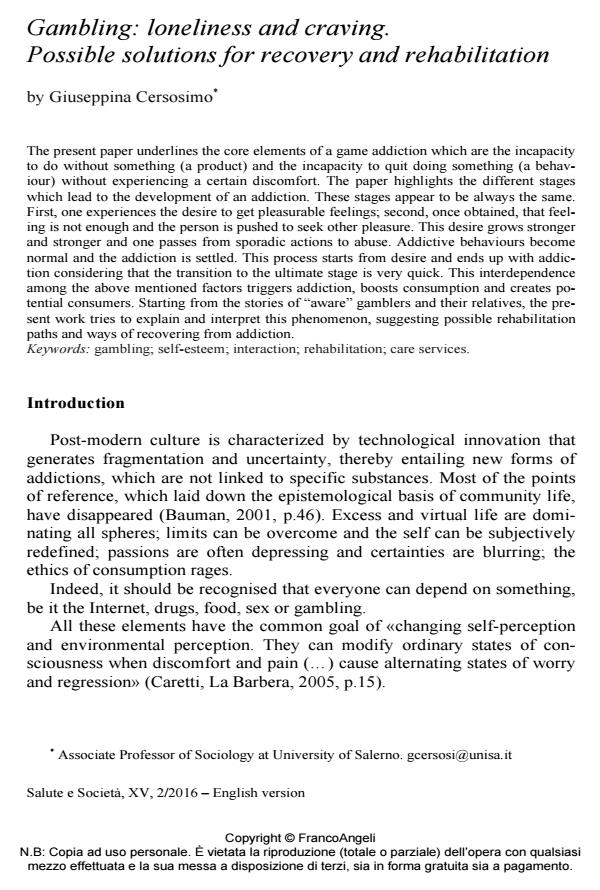Gambling: loneliness and craving. Possible solutions for recovery and rehabilitation
Titolo Rivista SALUTE E SOCIETÀ
Autori/Curatori Giuseppina Cersosimo
Anno di pubblicazione 2016 Fascicolo 2016/suppl. 2
Lingua Inglese Numero pagine 15 P. 112-126 Dimensione file 99 KB
DOI 10.3280/SES2016-SU2009
Il DOI è il codice a barre della proprietà intellettuale: per saperne di più
clicca qui
Qui sotto puoi vedere in anteprima la prima pagina di questo articolo.
Se questo articolo ti interessa, lo puoi acquistare (e scaricare in formato pdf) seguendo le facili indicazioni per acquistare il download credit. Acquista Download Credits per scaricare questo Articolo in formato PDF

FrancoAngeli è membro della Publishers International Linking Association, Inc (PILA)associazione indipendente e non profit per facilitare (attraverso i servizi tecnologici implementati da CrossRef.org) l’accesso degli studiosi ai contenuti digitali nelle pubblicazioni professionali e scientifiche
The present paper underlines the core elements of a game addiction which are the incapacity to do without something (a product) and the incapacity to quit doing something (a behaviour) without experiencing a certain discomfort. The paper highlights the different stages which lead to the development of an addiction. These stages appear to be always the same. First, one experiences the desire to get pleasurable feelings; second, once obtained, that feeling is not enough and the person is pushed to seek other pleasure. This desire grows stronger and stronger and one passes from sporadic actions to abuse. Addictive behaviours become normal and the addiction is settled. This process starts from desire and ends up with addiction considering that the transition to the ultimate stage is very quick. This interdependence among the above mentioned factors triggers addiction, boosts consumption and creates potential consumers. Starting from the stories of "aware" gamblers and their relatives, the present work tries to explain and interpret this phenomenon, suggesting possible rehabilitation paths and ways of recovering from addiction.
Parole chiave:Gambling; self-esteem; interaction; rehabilitation; care services.
- Cohen L.E., Felson M. (1979). Social Change and Crime Rate Trends: A Routine Activities Approach. American Sociological Review, 44: 588-607.
- Cohen A.K. (1963). Ragazzi delinquent. Milano: Feltrinelli.
- Cosgrave J.F., editor (2006). The Sociology of Risk and Gambling Reader. London: Routledge.
- Custer R. (1982). An overview of compulsive gambling. In: Caron P.A., Yolles S.F., Kieffen S.N., eds., Addictive Disordes Update: alcoholism, drug abuse, gambling. New York: Human Science Press, pp. 107-124.
- DSM–IV-TR (1995). Manuale diagnostico statistico dei disturbi mentali. Milano: Masson.
- Erikson K.T. (1962). Notes on the Sociology of Deviance. Social Problems, 9.
- Gaskell G. (2000). Individual and group interviewing. In: Bauer M.W. & Gaskell G., eds., Qualitative research: with text, image and sound. A practical handbook. London: Sage, pp. 39-56.
- Goffman E. (1970). Stigma. L’identità negate. Bari: Laterza [ed. orig. 1963].
- Goffman E. (1979). Espressione e identità. Milano: Mondadori [ed. orig. 1961].
- Humphreys A., Latour K.A. (2013). Framing the Game: Assessing the Impact of Cultural Representations on Consumer Perceptions of Legitimacy. Journal of Consumer Research, Vol. 40, No. 4: 773-795. DOI: 10.1086/672358HuizingaJ.(1939).HomoLudens:VersuscheinerBestimmungdesSpielementesderKultur.Amsterdam:PantheonAkademischeVerlagsanstalt;tr.it.HomoLudens.Torino:Einaudi,1982
- Kingma S.F., a cura di (2010). Global gambling: cultural perspectives on gambling organizations. London: Routledge.
- Lacroix M. (2002). Il culto dell’emozione. Milano: Vita e Pensiero.
- Lemert E.M. (1981). Devianza, problemi sociali e forme di controllo. Milano: Giuffrè.
- Ritzer G., Stillman T. (2001). The modern Las Vegas casino-hotel: The paradigmatic new means of consumption. M@n@gement, 4(3): 83-99.
- Sykes G.M., Matza D. (1957). Techniques of Neutralization: A Theory of Delinquency. American Sociological Review, 22: 664-670.
- Toffa N. (2014). Quando il gioco si fa duro. Dalle slot machine alle lotterie di Stato: come difendersi in un Paese stravolto dall’azzardomania. Milano: Rizzoli.
- Wynn S. (1980). Expansion of Legalized Gaming and Factors that will Influence. Paper presented at the Laventhol and Horwath Second Annual Gaming Conference at the Waldorf-Astoria, New York City.
- Caretti V., La Barbera D. (2005). Le dipendenze patologiche. Milano: Raffaello Cortina.
- Bauman Z. (2001). Voglia di comunità. Roma – Bari: Ed. Laterza.
- Becker H. (1963). The Other Side: Perspectives on Deviance. New York: The Free Press.
- Berger A. (1998). Chapter 6, Depth Interviews: favorite singers and recordings. In: Berger A., ed., Media research techniques (2 ed., pp. 55-62). London: Sage.
- Berger P.L. (1970). Invito alla sociologia. Padova: Marsilio.
- Berger P.L., Berger B. (1977). Sociologia. La dimensione sociale della vita quotidiana. Bologna: Il Mulino.
- Berger P.L., Luckmann G. (1969). La realtà come costruzione sociale. Bologna: Il Mulino.
- Caillois R. (1950). L’Homme et le sacrè. Paris: Gallimard; tr. it. L’uomo e il sacro. Milano: Bollati Boringhieri, 2001.
- Caillois R. (1958). Les jeux et les homes: le masque er le vertige. Paris: Gallimard; tr. it. I giochi e gli uomini: la maschera e la vertigine. Milano: Bompiani, 1988.
Giuseppina Cersosimo, Gambling: loneliness and craving. Possible solutions for recovery and rehabilitation in "SALUTE E SOCIETÀ" suppl. 2/2016, pp 112-126, DOI: 10.3280/SES2016-SU2009